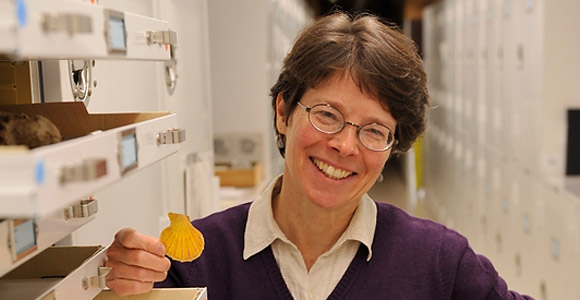
Eye on the Quads
Written in Stone
Rock star Susan Kidwell on pure fun, the fossil record, and her favorite bivalve.
By Benjamin Recchie, AB’03 | Photo by Bill Denison
Susan Kidwell, the William Rainey Harper professor of geophysical sciences, never intended to teach. “The fewer students, the better,” she says of her early philosophy. But in 1981, at the University of Arizona, she first found herself teaching a class of undergraduates—and she loved it. Her students, then and now, have loved her back; she won a Quantrell Award in 1999 in recognition of her undergraduate teaching.
Kidwell’s research focuses on the development of the fossil record, especially modern coastal ecosystems. “The challenge for me,” she says, “is not to lose too much research time to doing an ever-better job at teaching.”
How did you come around to enjoying teaching?
Chance momentum carried me past an offer to go into industry early in my career, and universities were among the few other places where I could work in Earth sciences, so I found myself teaching college. I thought the rewards might come 20 years later if some former student, when receiving an award, said they owed it all to you.
Instead, I discovered that the rewards come every day when, by the look on a face, you can see they really, truly get it.
What’s the most fun thing you teach?
Upper-level stratigraphy is fun. I teach students how to describe and analyze rocks and put strata in a context of space and time. This basic geological sense is essential yet gets short shrift in geology education.
The physical sciences Core course on the environmental history of the earth is exhausting but rewarding, because it’s outreach to nonscientists. You have to convey the fascinating complexity and elegance of science with minimal jargon.
The most purely fun, however, are the field courses on modern and ancient sedimentary environments. I get to take students out into the field, help them connect book learning with reality, then set them free to do an original piece of pilot research. We all come home absolutely dragging, with bug bites and scratches, but exhilarated.
Your research revolves around not just fossils but also the formation of the fossil record. What can we learn from that?
I’m interested in the balance between the destruction and burial of mineralized hard parts, like shells and bones, and in the quality of the biological information that’s captured by sedimentary rock. I’m also interested in the same issues about the rock record itself.
I’m trying to understand the nature and formation of gaps in records—to learn how to extract reliable historical information from records that are thin and possibly biased.
A few years ago, my motivations shifted dramatically toward historical ecology. I realized just how much modern coastal ecosystems have been modified by human activities over the past few centuries—and those changes are only accelerating.
Much of your work concerns the ocean floor. Why is that area interesting?
First, the soft sediments that make up the floor of coastal seas and the deep ocean are the world’s largest biome. But scientists don’t work on it much, because it’s logistically difficult.
Public awareness of the state of our oceans has increased in the past decade, but that’s mostly because of their increasingly shocking degradation. There’s the exploitation of fish and other organisms high on the food chain, runoff of nutrients creating dead zones even in the open ocean, and massive habitat alteration arising from bottom-trawling, armoring of shorelines, and loss of vegetation like mangroves and seagrass.
At first I was interested in fossils records 20 million years old and older. Today my focus is primarily on human impacts. I look at very young fossil records, spanning the past few decades back to a few tens of thousands of years.
What’s the most enjoyable part of your research?
If I said “everything” you wouldn’t believe me, but if you can’t find a kind of Zen even in the supposed drudgery, then why do it?
That said, I guess I most enjoy data generation and discovery, the thrill of that hunt and designing the campaign. That used to entail a lot of fieldwork outdoors. But for the past five years it has mostly entailed Dumpster diving—rescuing the unused grunge of marine biological samples and turning it into data, and finding existing data that can be put to new uses.
This is the phase of a project when you get the initial sense of what’s really going on in a system. You find yourself getting up earlier and earlier and going to bed later and later so that you can max your time pounding away.
Do you have a favorite sea-dwelling creature, living or fossilized?
Absolutely—you can’t beat clams. They are diverse, abundant, present in all waters, and have a great fossil record going back to the early Paleozoic. And they make functional sense. It’s pretty straightforward to figure out their life habits from simple morphology, even for extinct species.
